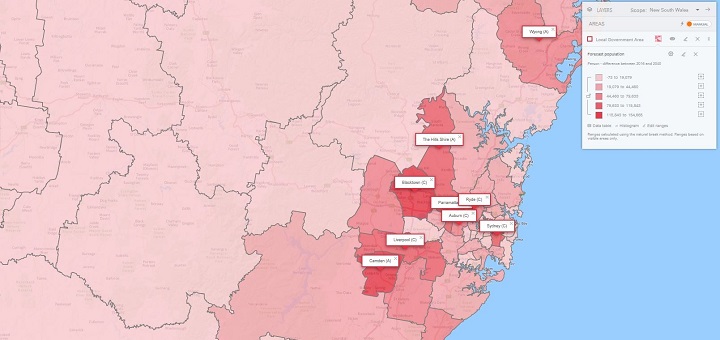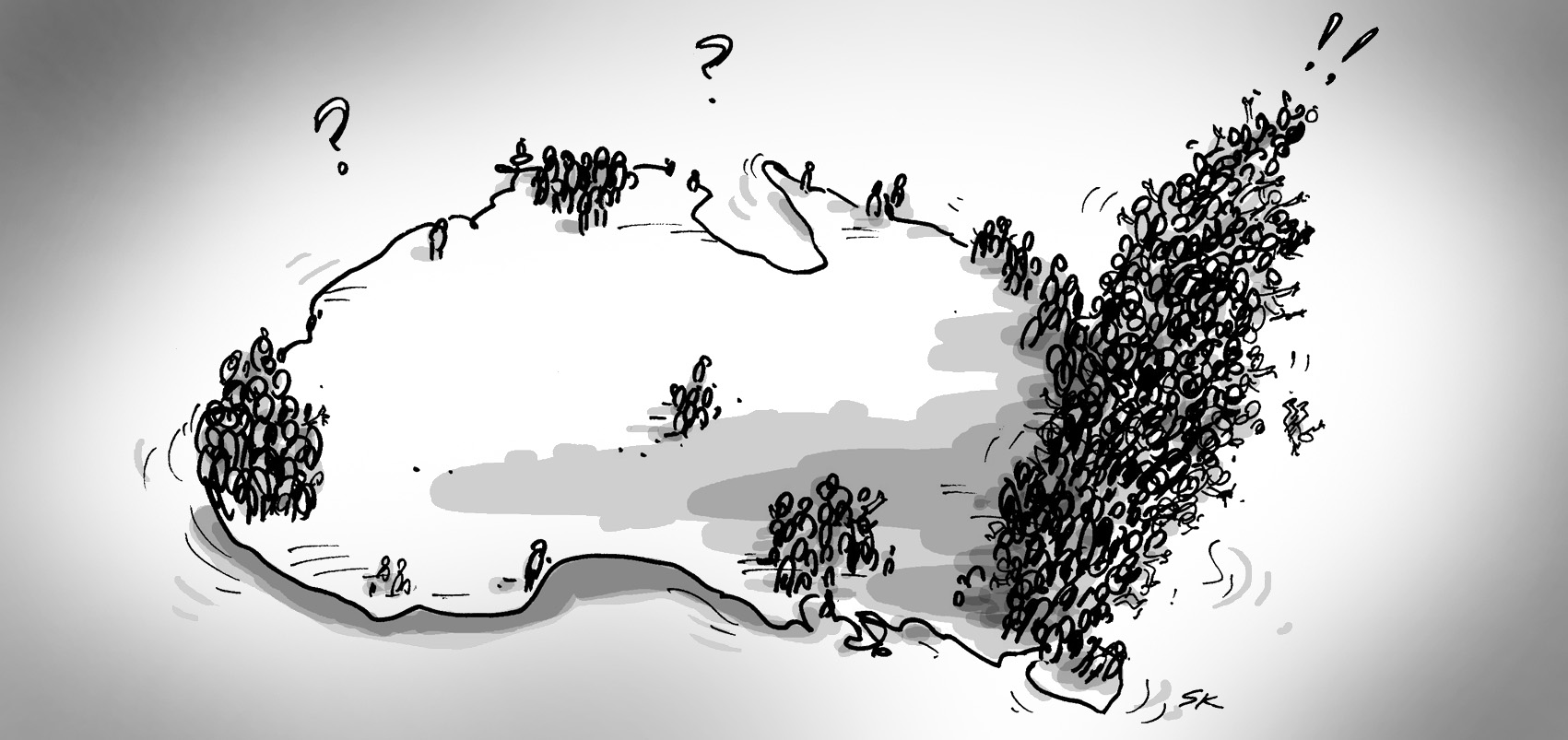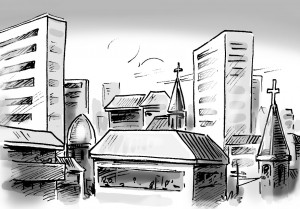Every year about this time we get an update on population growth at the local level. The ABS updates national and state populations every quarter, but local areas only once a year, in their Regional Population Growth publication.
In 2014, there are a few interesting trends at the regional level.
Greater Sydney has just topped 4.84 million, and is closing in on the 5 million mark, adding 84,200 people in the last year. Greater Melbourne is at 4.44 million, and added 95,700 people in the last year. So it’s still growing faster than Sydney, but Sydney’s accelerated again, so at this rate it will be after 2050 before Melbourne overtakes Sydney as Australia’s largest city.
Brisbane (1.7%) is now growing at a slower rate than either Melbourne (2.2%) or Sydney (1.8%). While Perth continues to be the fastest growing capital at 2.5%, adding nearly 50,000 people in a year, to top the 2 million mark for the first time.
And, at the local government level?
The fastest growing LGA in Australia is once again Serpentine-Jarrahdale Shire, on the south-east fringe of Perth. Fastest growth can be a little misleading, because in percentage terms you more easily attain a high growth from a small population. S-J Shire (as it’s locally known) grew by 6.8%, or 1,438 people, to a population of 22,698. .id’s population forecasts have S-J growing to over 63,000 by 2036.
In contrast, the largest growth (greatest number of people added to the population) is almost always the City of Brisbane, because it has a million people in it, and covers much of the metropolitan area. Brisbane grew at a modest 1.5% but added nearly 17,000 people in 2014.
The biggest population decline and the fastest population decline were the same area – Derby-West Kimberley council in Western Australia, which lost 517 people, or 5.4% of its population in a year.
New South Wales
Camden is the fastest growing area in NSW, adding 3,845 people, or 6.1% in a year. Growth is accelerating here, after being relatively slow for a while. Unusually, Botany Bay has slipped into second place, with 3.4% growth, followed by the City of Sydney and Canada Bay (which was #1 for several years). The City of Sydney has almost reached 200,000 people.
Declining areas were mostly in the western parts of the state, with Moree Plains losing 1.1%, or 156 people to have the largest decline in NSW.
Victoria
Growing at 1.9% overall, Victoria is the second-fastest growing state now. The City of Wyndham, on Melbourne’s western fringe, has been adding over 10,000 people per year for the past decade, and 2014 is no exception. It grew by 10,604 people, 5.6%, to be Victoria’s fastest growing area, and 3rd in Australia. Not bad for a population which is now quite large, at a shade under 200k (199,715). Inner Melbourne (Melbourne City Council) also had very strong growth of 5.0%, followed by other fringe areas, Whittlesea (4.4%), Melton (4.0%) and Cardinia (3.6%).
On the other side of the coin, most of the population declines were in the Mallee-Wimmera area in North-West Victoria, with West Wimmera losing 2.5% of its population, and Swan Hill having the largest decline of 275 people.
Queensland
It is a measure of just how much Queensland’s population growth has slowed, that topping the list for fastest growth in 2014 is the tiny, remote, mostly Indigenous community of Northern Peninsula Area Regional Council, which grew by 4.1%, or the grand sum of 106 people! The top 4 are all regional – this was followed by the regional centre of Gladstone (3.5%), Somerset (3.0%) and Scenic Rim (2.9%). Ipswich is the fastest growing metropolitan area, at 2.8%.
Gold Coast for many years added 15,000 people or more per year but in 2014, it only grew by 8,790 people, or 1.6%. This means that Gold Coast is now growing more slowly than the whole state of Victoria!
The largest decline in Queensland was in Cook Shire, which lost 3.1%, or 135 people. This adjoins Northern Peninsula, so there may have been some population exchange there?
South Australia
South Australia continues to be the slowest growing mainland state, adding only 0.9% in 2013/14.
The fastest growing area was the satellite town of Gawler (2.8%, or 595 people), followed by central Adelaide (2.2%), and outer suburban Playford (1,816 people, also 2.2%). Many regional centres experienced small population declines, but the largest decline was in Wattle Range District Council, near Mount Gambier, which lose 88 people, or 0.8%.
Western Australia
Still the fastest growing state, at 2.2%, but slowing down a lot from a couple of years ago. The South-East of Perth has the fastest growth, with S-J Shire topping the nation at 6.8% growth, but neighbouring Armadale added more than twice as many people to a larger population base, at 5.2%, also one of the fastest growing in the country.
This is followed by other fast growing outer parts of Perth, Kwinana (5.0%), Swan (4.1%) and Wanneroo (4.1%). Chittering Shire, just beyond Perth’s fringe, is also in there, at 5.0%, adding 223 people in 2014.
WA also has the largest and fastest population decline in the country, with Derby-West Kimberley losing 517 people.
Tasmania
Tasmania’s population growth continues to languish. After some fairly strong growth of 18,000 people between 2006 and 2011, in the 3 years since it’s added just 3,400, with percentage growth of 0.3% in the last year. The fastest growth is in Latrobe Municpality, on the outskirts of Devonport in the north, which added 1.8%, 195 people. This was followed, in a quirk of statistics by tiny Tasman council (Port Arthur and surrounds), adding 35 people, or 1.5% to its population.
The largest growth was in the City of Clarence, on Hobart’s east shore, adding 491 people.
Northern Territory
The Territory’s overall growth rate of 1.0% belies the fact that Darwin is growing really strongly (2.2%) but the rest of the Territory is quite slow or negative.
The fastest growing area is Palmerston City, adding 5.2%, or 1,692 people, one of the fastest growing in the country.
All current population estimates have now been updated on our clients’ profile.id and economy.id websites. Don’t forget though, that these figures are all subject to review after the next Census. Another reason we need the Census every 5 years, to check the accuracy of the interim population estimates!











